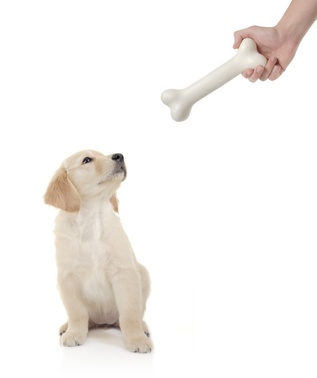About Chew Bones and Labrador Retriever Care
Dogs love bones, making them an important part of Labrador Retriever care. At this point I should make clear that we are discussing chew bones and not actual bones left over from the Sunday joint for example.
There are lots of chew bones now in pet stores and the Lab owner is presented with a bewildering choice when out treat shopping.
Elsewhere on the site we discuss lots of other aspects of Labrador Retriever care including dental health, more general health issues and senior dog carebut, in this article, expert vets from Drs Foster and Smith look at different chew bones, their benefits when thinking about Labrador Retriever care and which chew bones you should choose for your dog.

Chew Bones: The Many Benefits & How to Choose One
When you give a dog a chew bone, you're doing a lot more than giving him something to chew on.
Benefits of bones
Chewing on bones (rawhide, nylon, or starch-based) helps dogs of all ages in a number of ways. In using the term 'bones' we do not mean bones leftover from a roast, etc., which may cause digestive problems and which are too abrasive and can wear down the teeth.
Instead, we mean chew bones specifically designed for dogs. Whether your dog prefers rawhide bones or the extra-hard choices for aggressive chewers, here are a few ways chew bones benefit dogs:
Provide Dental Benefits
Chewing on chew bones is good for your dog's teeth. In our practice, the vast majority of dogs we see and treat for dental problems are dogs that have not chewed on enough hard objects, whether they are toys or bones.
Chewing on dog chew bones or hard toys helps scrape away plaque, which can cause bad breath and a number of potentially serious dental problems.
The action of the bone against the teeth scrapes away plaque and controls tartar buildup - helping prevent periodontal disease and yellowing of teeth.
Hard bones like pressed rawhide or any of the Nylabone products help scrape off even the most stubborn plaque, keeping exposed surfaces smooth and harder for plaque to adhere to.
Relieve Boredom
Not unlike humans, dogs that do not have anything to do get bored. A chew bone will entertain your dog for hours and keep his mind stimulated, which is good for dogs of all ages, especially older dogs that are not as active. Just remember, your house gets pretty dull when you are not there all day.
Satisfy the Urge to Chew
Dogs, and especially puppies, have an innate urge to chew. Chew bones are a much better alternative to satisfying your dog's urge to chew than the leg of your elegant dining room table or your new pair of hiking boots.
For teething puppies, chewing on a chew bone or chew toy helps stimulate the growth of adult teeth. Like human infants, the pressure on a dog's teeth and gums from chewing on something hard helps relieve any discomfort from the new teeth pushing through the gums.
Choosing the right bone
Choose a bone that matches your dog's chewing rate and chewing habits. Consider size, shape, hardness, and flavor.
Size
Some pets are very particular about the size of the chew bone you give them. Too big and they will not touch it, even though they will chew for hours on a smaller bone. Generally speaking, smaller dogs prefer smaller bones, but the reverse is not always true.
Many bigger dogs ignore big bones, leading owners to believe, incorrectly, that bones do not interest them. Some dogs will not touch a rawhide bone that they find too big. The same rawhide in a smaller size is chewed immediately.
Hardness and Texture
In addition to size, the consistency of the bone you give your dog is another factor to consider. Aggressive chewers can chew down a good size bone in a surprisingly short time.
For these dogs, try giving pressed rawhide which is compressed, harder, and will last longer. Synthetic bones such as Nylabones are also excellent choices for a long-lasting chew.
If your dog chews for short periods of time with a soft bite, a smaller rawhide bone that is easy to soften will be more enjoyable.
For these dogs, also try rawhide chips, sticks, or twists. These options satisfy the urge to chew, provide just as much entertainment, and taste just as good as any chew bone.
Flavor
Finally, the flavor is very important to some dogs. Certain dogs like peanut butter-flavored bones while others like theirs hickory-smoked. Again, try various types to see which ones your dog enjoys.
Remember, almost all dogs like to chew. Oftentimes, the trick is finding the right size, consistency, and flavor your pet wants. Try to find a few types your dog enjoys.
When he loses interest in the one he is working on, switch to the other. This will keep your dog chewing, which we all know is great for helping remove plaque and relieving boredom.
Reprinted as a courtesy and with permission from PetEducation.com
Related Labrador Retriever Care Articles
Labrador Retriever Care - Dental Health
How To Brush Your Labs Teeth
Labrador Health Care